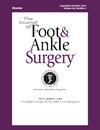Morphological analysis of the retrotalar pulley and its role in flexor hallucis longus impingement: Insights from a CT-based study
IF 1.3
4区 医学
Q2 Medicine
引用次数: 0
Abstract
The Flexor Hallucis Longus (FHL) is a muscle that can be subject to multiple conflicts. The most common conflict is due to inflammation of the tendon at the retrotalar pulley. The constraints exerted on the FHL are responsible for a pathology called functional Hallux Limitus.
The purpose of this anatomical study is to describe morphologic finding about retrotalar pulley, which may account the impingement between FHL and the hindfoot. Using a retrospective approach at a single center, a detailed analysis was conducted on a cohort of 350 patients. Precise measurements were taken to document the angles, areas, and distances that define the relationship between the Flexor Hallucis Longus (FHL) tendon and its surrounding anatomical structures.
The angle between the retrotalar pulley and the sustentaculum tali exhibited a range of 124 to 170 degrees in profile and 113.3 to 178 degrees in frontal view. The dimensions of the retrotalar pulley varied from 1.1 to 54 mm², while the posterolateral and posteromedial tubercles displayed dimensions ranging from 3.4 to 77.9 mm² and 2.6 to 35.2 mm², respectively. Distances between posterior tubercles further underscored the anatomical diversity, ranging from 4.3 to 17 cm proximally and 10.5 to 18.4 cm distally.
In unraveling the morphological complexities surrounding FHL impingement, this study provides valuable insights into the biomechanical intricacies of the foot. These findings not only deepen our understanding of musculoskeletal anatomy but also pave the way for future investigations into the dynamic interplay between structure and function in the lower extremities.
后距滑轮的形态分析及其在幻觉长屈肌撞击中的作用:基于ct的研究的见解。
幻觉长屈肌(FHL)是一块可以受到多种冲突的肌肉。最常见的冲突是由于距后滑轮肌腱的炎症。对拇外翻的约束导致了一种叫做功能性拇外翻限制症的病理。本解剖研究的目的是描述关于足后滑轮的形态学发现,这可能解释了FHL与后足之间的撞击。采用单中心回顾性方法,对350例患者进行了详细分析。采用精确的测量来记录角度、面积和距离,以确定幻觉长屈肌肌腱与其周围解剖结构之间的关系。距后滑轮与talentaculi之间的角度在侧面为124 ~ 170度,正面为113.3 ~ 178度。距后滑轮的尺寸从1.1到54 mm²不等,而后外侧和后内侧结节的尺寸分别为3.4到77.9 mm²和2.6到35.2 mm²。后结节之间的距离进一步强调了解剖多样性,近端为4.3至17厘米,远端为10.5至18.4厘米。在揭示FHL撞击周围的形态学复杂性时,本研究为足部的生物力学复杂性提供了有价值的见解。这些发现不仅加深了我们对肌肉骨骼解剖学的理解,而且为未来研究下肢结构和功能之间的动态相互作用铺平了道路。
本文章由计算机程序翻译,如有差异,请以英文原文为准。
求助全文
约1分钟内获得全文
求助全文
来源期刊

Journal of Foot & Ankle Surgery
ORTHOPEDICS-SURGERY
CiteScore
2.30
自引率
7.70%
发文量
234
审稿时长
29.8 weeks
期刊介绍:
The Journal of Foot & Ankle Surgery is the leading source for original, clinically-focused articles on the surgical and medical management of the foot and ankle. Each bi-monthly, peer-reviewed issue addresses relevant topics to the profession, such as: adult reconstruction of the forefoot; adult reconstruction of the hindfoot and ankle; diabetes; medicine/rheumatology; pediatrics; research; sports medicine; trauma; and tumors.
 求助内容:
求助内容: 应助结果提醒方式:
应助结果提醒方式:


